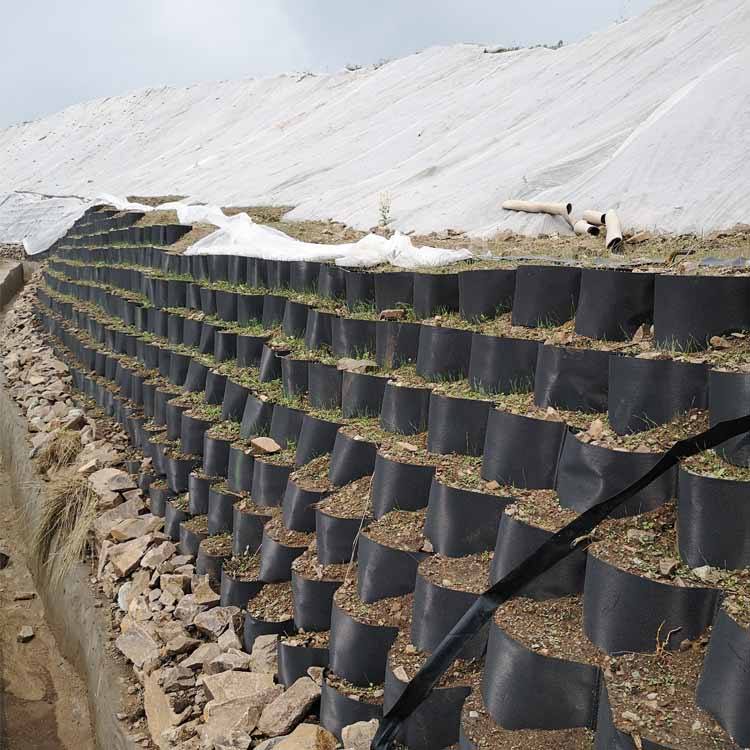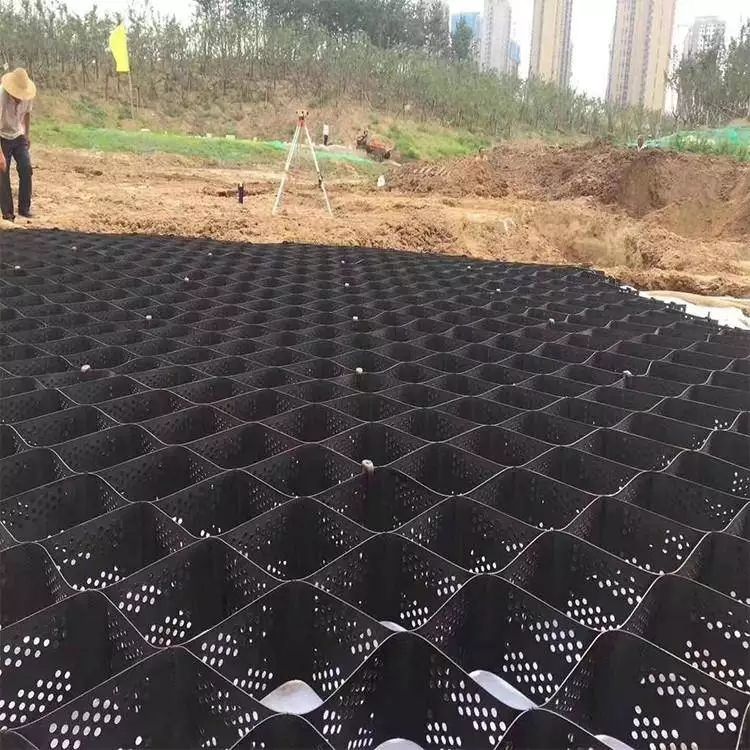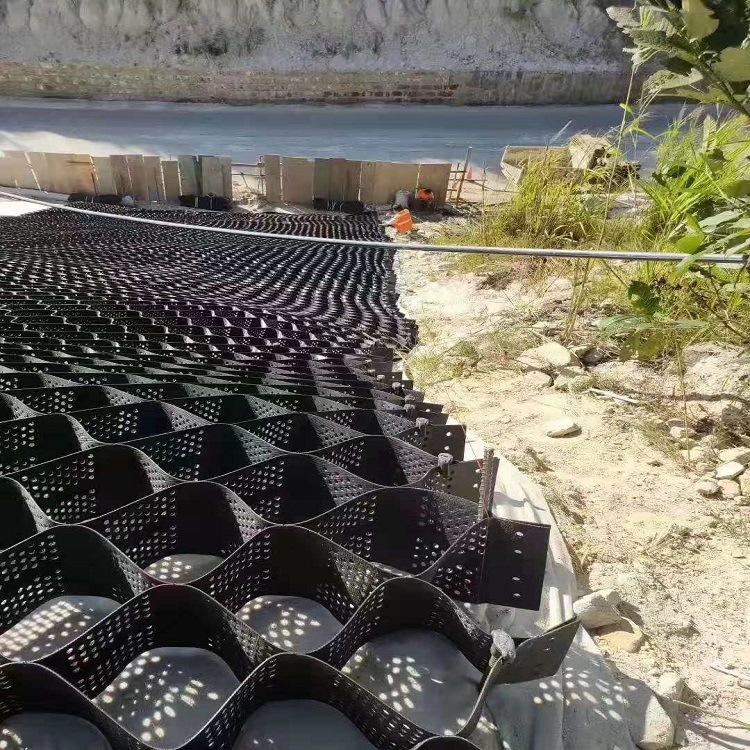The "soil-fixing net" that cannot be dispersed by water flow! Geocells help with ecological river slope protection, making soil and water conservation more long-lasting
Imagine walking along your town’s river the morning after a summer thunderstorm. The air smells like wet dirt, but then you notice something off: parts of the bank are bare, mud clumps bobbing in the current, and little cracks snaking through the earth—signs it’s starting to crumble. For towns that count on rivers for clean drinking water, keeping floods at bay, or keeping local wildlife healthy, this erosion isn’t just an eyesore. It’s a critical threat.
The old fixes only make things worse. Stacking concrete blocks? They’re like cold walls—they hold back water for a year or two, but they smother native plants, cut off fish and bugs from the shore, and crack easily. You end up patching them nonstop. Sandbags are even worse: they rot within 12 months, leaving piles of gross debris that clog the river. But lately, engineers have been using something simpler, and way smarter: geocells. Think of them as an unwashable “soil-grip”—they keep riverbanks steady and let nature do its thing. And here’s a surprise: the same design that makes geocell driveways so durable works perfectly here, too.
1. The Honeycomb Secret: How Geocells Stop Erosion
Let’s keep it simple—what are geocells, exactly? They’re not fancy tech. Just thin, tough panels made from high-density polyethylene (HDPE)—the same stuff that makes those durable plastic storage bins you see in garages, or the heavy-duty pipes that don’t rust underground. When you pull them open, they pop into a honeycomb grid of little open cells. Lay that grid along the riverbank, fill each cell with local soil, gravel, or even a mix of dirt and grass seeds, and suddenly you’ve got a layer that locks soil in place like a glove.
The magic’s in that honeycomb shape. When fast water hits the bank, the geocells spread the current’s force across the whole grid. Instead of the water carving a gully in one spot, it just slides over the top—no damage done. And unlike concrete, which turns the bank into a dead zone where nothing grows, the stuff you fill the cells with lets plants push through. That’s a game-changer for the river’s ecosystem.
Now, here’s a fun overlap: this same honeycomb trick is what makes geocell driveways so tough. If you’ve seen a driveway that doesn’t get ruts after rain, it’s probably using geocells—they hold gravel or asphalt in place so the surface doesn’t sink. Riverbank geocells do the exact same thing, just on a bigger scale. A lot of contractors who’ve used geocells for driveways now use them for rivers, too—they already know the design works. No guesswork, just proof.
2. Geocells: Letting Nature Do the Real Work
The worst part about old riverbank fixes is how they hurt the environment. Concrete stops water from seeping into the ground, so nearby plants dry up and die. It also blocks bugs, frogs, and small animals from moving between land and water—bad news for fish that eat those bugs, or birds that nest near the shore. Geocells fix all that, and then some.
Fill those geocell cells with local soil and a handful of native seeds—think tough grasses, clover, or wildflowers that love wet ground—and wait a few weeks. The seeds sprout, pushing through the grid’s gaps until the whole bank is green. Those plants’ roots don’t just hold soil—they act like tiny anchors, weaving through the geocells and digging into the bank’s core, making it even stronger. They soak up extra rainwater so the bank doesn’t get waterlogged, filter runoff before it hits the river (trapping dirt and chemicals that harm fish), and give bugs a place to live—which feeds birds and fish. It’s a double win: the bank stays intact, and the river’s ecosystem gets healthier.
And geocells are eco-friendly from the start. They’re made from recyclable HDPE, so no chemicals leak into the water or soil. Unlike sandbags that fall apart and create trash, geocells last 15 to 20 years with almost no maintenance. Plus, just like geocell driveways—no toxic sealants, no need to resurface every year—riverbank geocells keep the area clean and low-fuss. This isn’t just fixing erosion. It’s erosion control that doesn’t just patch a problem—it helps the river’s ecosystem bounce back, too.
3. Real-World Results: A Small Town’s Riverbank Makeover
Let’s take a look at a real example to see how well this works. Last year, the town of Mill Creek (a small community in the Pacific Northwest) had a problem with its main river, the Creekwood. Every winter, heavy rains would wash away soil from the riverbank, and by spring, the town had to spend $20,000 or more to repair the damage. They’d tried sandbags and even a short stretch of concrete, but nothing stuck.
Then they hired an engineering team that recommended geocells. The team laid 500 square meters of geocells along the most eroded part of the bank, filled them with local soil and a mix of grass and wildflower seeds, and finished the job in just three days. By summer, the bank was covered in green grass, and when winter rains came, something surprising happened: not a single chunk of soil washed away.
“The difference is night and day,” said Sarah Lopez, Mill Creek’s public works director. “We used to get calls every time it rained about the riverbank collapsing. Now? Nothing. And the best part is, the geese and herons are back—they love the plants growing there.”
What’s interesting is that the team also mentioned geocell driveway systems during the project. They told the town that if they ever needed to repair the local park’s parking lot (which was sinking), they could use the same geocell technology—proving how versatile these products are.
4. Why Geocells Beat Traditional Methods (And Save Money)
Let’s be honest: cost matters for most towns and cities. Traditional riverbank protection isn’t just bad for the environment—it’s expensive. Concrete blocks cost around
15 to 20 per square foot, and installing them takes weeks (which means paying workers longer). Sandbags are cheaper upfront (2 to 3 each), but they only last 1 to 2 years and need to be replaced constantly.
Geocells, on the other hand, cost about 5 to At around $8 per square foot, geocells undercut concrete by a solid margin—and they outlast sandbags by years, no contest. Installation’s quick, too: a small crew—maybe 2 or 3 people—can knock out 100 square meters in a single day. That cuts down on labor bills big time. And since they last 15+ years, you’re not stuck shelling out for annual repairs like you are with sandbags or cracked concrete.
Think about geocell driveways—if you skip geocells for a gravel driveway, you’re stuck filling potholes every spring and replacing the whole gravel layer every 3 to 5 years. A geocell driveway costs a touch more upfront, but it sits solid for 10+ years without you lifting a finger. Riverbank geocells follow that same common sense: spend a little more now, save a ton later. No more yearly fixes, no more surprise bills.
Another huge plus? They’re flexible. Concrete cracks the second the ground shifts—say, when winter freezes expand the soil, then spring thaws shrink it back. Geocells? They flex with the earth, like a rubber mat. No cracks, no hassle. That’s a big deal for riverbanks, which are always shifting a little—even if you can’t see it. And if something small goes wrong, like a fallen tree scraping a section of the grid? You just replace that one spot, not the whole thing. Try doing that with concrete—you’d have to jackhammer the old stuff and start over.
5. Installing Riverbank Geocells: Easier Than You’d Guess
You might be thinking: “This sounds great, but is it a pain to install?” Spoiler: It’s not—most crews with basic construction know-how can handle it. Here’s how it usually goes:
First, prep the bank. Yank out dead plants, scoop up loose rocks, and haul away any junk cluttering the area. Then smooth out the surface a bit—no need for perfection, just enough so the geocells lie flat without bunching up. Next, pull the geocell panels open (they fold up small for transport) and stake ’em to the ground—most geocell kits come with the stakes included, so you don’t have to buy extra. Once the panels are secured, fill each little cell with whatever material works best—local soil is ideal, but mix in some gravel if you need better drainage (like in super wet areas). Finally, water the whole thing if it’s not raining—this helps the soil settle, and if you added grass or wildflower seeds, it gets them sprouting.
Heck, it’s nearly identical to putting in a geocell driveway. For driveways, you prep the dirt, lay the geocells, fill ’em with gravel or asphalt, and you’re good to go. The only real difference? Riverbank geocells are usually laid at a slight angle (to match the bank’s slope) instead of flat. And since they’re lightweight—you can carry a folded panel with one hand—you don’t need big machinery. Just a few shovels, a rake, and those included stakes.
One quick tip: If you can, install geocells when it’s dry. Rain turns the soil into slippery muck—hard to walk on, even harder to get the geocells to stay put. But even if a light shower hits mid-install, don’t stress—geocells are water-resistant, so they won’t get ruined. You just might have to wait a bit for the soil to dry out before finishing the filling.
6. The Future of Riverbank Protection: Geocells Are Here to Stay
As more towns and cities focus on eco-friendly infrastructure, geocells are becoming the go-to choice for riverbank protection. They check all the boxes: they’re cheap, easy to install, long-lasting, and good for the environment. And with climate change making heavy rains more common, we need solutions that can handle more extreme weather—something geocells do well.
We’re also seeing geocells used in more creative ways. Some teams are using them to restore wetlands along rivers, filling the cells with mud and wetland plants to create habitats for frogs and turtles. Others are combining geocells with small stone walls to create “stepped” riverbanks that are even more stable.
And let’s not forget geocell driveway systems—they’re part of this trend too. As people look for durable, eco-friendly ways to upgrade their homes, geocell driveways are growing in popularity. It’s all part of a bigger shift: moving away from harsh, wasteful construction methods and toward solutions that work with nature, not against it.
Wrapping Up For too long, riverbank protection was a choice between “effective” and “eco-friendly.” Geocells change that—they’re both. They’re the “soil-fixing net” that water can’t wash away, keeping riverbanks stable for decades while letting plants grow and wildlife thrive. And whether you’re using them for a riverbank or a geocell driveway, you’re getting a product that’s reliable, affordable, and kind to the planet.
If your town or city is struggling with riverbank erosion, it’s worth looking into geocells. Talk to a local engineering team that has experience with them—they can show you examples of projects in your area and help you figure out if geocells are right for your river. After all, a healthy riverbank isn’t just good for the environment—it’s good for the people who live near it too.







